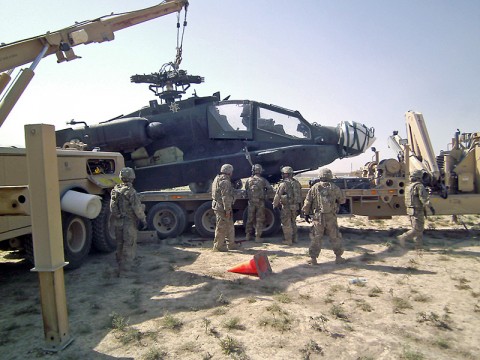Written by Sgt. 1st Class Peter Mayes
101st Sustainment Brigade, 101st Airborne Division (AA) Public Affairs

 Bagram Airfield, Afghanistan – Soldier with the 101st Sustainment Brigade are no strangers to the effectiveness of the Army’s new joint recovery and distribution system. It was their input and recommendations that directly resulted in the equipment’s fielding to Operation Enduring Freedom.
Bagram Airfield, Afghanistan – Soldier with the 101st Sustainment Brigade are no strangers to the effectiveness of the Army’s new joint recovery and distribution system. It was their input and recommendations that directly resulted in the equipment’s fielding to Operation Enduring Freedom.
The vehicle’s effectiveness in a combat environment showed itself as the 584th Maintenance Company recently used the JRADS to recover a downed Apache helicopter. It took the recovery approximately four hours to safely recover and transport the aircraft back to Bagram Airfield, company officials said.

This was the fourth recovery mission the company has conducted since being deployed to Afghanistan this past April in support of Operation Enduring Freedom. Sgt. Brandon Allen, a wheel vehicle mechanic with the 584th Maintainence Company, said the unit has also recovered a bulldozer, a wrecker, and a mine resistance ambush protected vehicle.
Allen, who was a member of the recent Apache recovery mission, said the recovery team consisted of two JRADS and a mine-resistant recovery vehicle, a new wrecker system the Army is also fielding. The team headed to an area close to BAF to retrieve the Apache, he said.
Allen said the recovery mission was made easier with having two JRADS on the scene. “We put the front portion of the Apache on one JRADS, and the rear portion and other sensitive items from the aircraft on the other,” he said.
The sergeant sang the praises of the JRADS system. “It was great for the mission. It worked perfect. The length of it gave us enough clearance to get everything loaded up on one trip,” he said. “The JRADS ability to lower its trailer out there helped out a lot because we didn’t have to lift the Apache any higher than we needed to.”
The 101st Sustainment Brigade began training on the JRADS system this past year back at Fort Campbell. The recovery team worked closely with designers at Boeing on training with the new system, as well as providing insight into what would make the new system more combat effective.
The brigade also sent a team to Scott Air Force Base in Illinois to test and demonstrate the improvements made to the system this past summer.
The company deployed to Afghanistan in April, and began training on the new system here in Afghanistan.
Allen, like many of the soldiers operating the JRADS system here, said he conducted recovery missions while deployed to Iraq and noticed the differences between the two regions.
“The terrain and drivability on some of the roads there in Iraq were much better there,” he said. “Using the other recovery vehicles that we used in Iraq here would have been more difficult, but the JRADS turning radius makes it easier for us to maneuver out there.”
Herntenstein said the combination of the JRADS and MRV made the vehicle recovery mission much better.
“They are a perfect complement to each other every step of the way,” she said.


